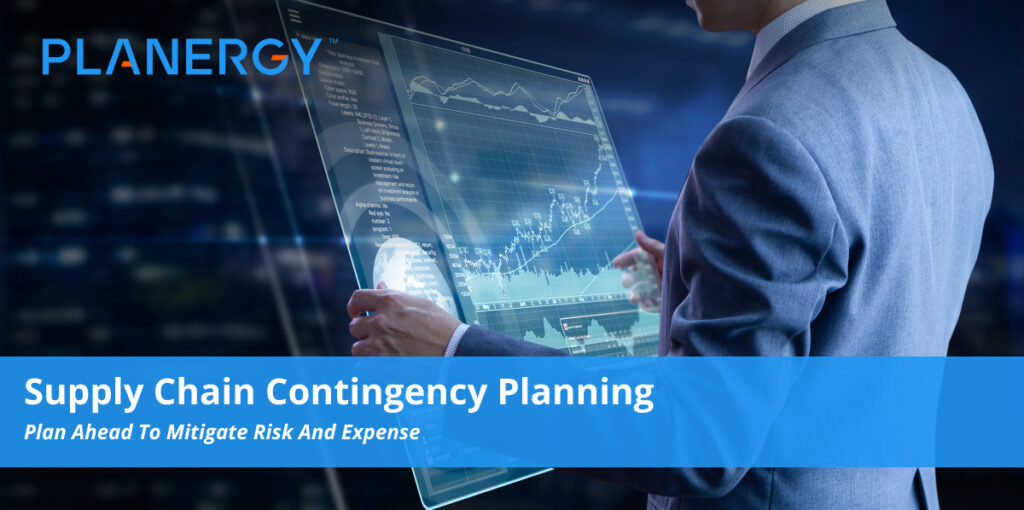Your supply chain is the lifeblood of your business. And ignoring the potential disruptions—whether minor or major—that can limit or even stop its flow can spell disaster for your business.
In today’s uncertain world, where global supply chains stretch across international boundaries and grow increasingly complex with every passing day, a supply chain contingency plan is an essential part of both effective supply chain management and overall risk management for your business.
Effective supply chain contingency planning is easier than you may think.
By understanding your business needs, investing in the right tools, and implementing a few simple best practices, you can guard against both short-term and long-term supply chain disruptions, improve your risk mitigation and disaster recovery capabilities, and protect business continuity when it matters most.
Why You Need a Supply Chain Contingency Plan
The COVID-19 novel coronavirus pandemic taught businesses around the world a bitter lesson about the importance of effective supply chain management, contingency planning, and risk mitigation.
But in a world where even a global pandemic is just one of many potential supply chain disruptions—joined by natural disasters like the Amazon Rainforest Fires, political upheaval, ethical procurement crises, cyberattacks, and more—strategic sourcing, and supply chain contingency planning are practically one and the same.
2020 research conducted by McKinsey and Co. found the multiple major supply chain disruptions that occurred in the last year were likely to cost companies nearly half of one year’s earnings over the course of the coming decade.
Those losses were likely to be compounded by losses to more efficient competitors and the need to rebuild company infrastructure (both virtual and physical).
However, McKinsey cautioned that they could be reliably mitigated for companies who invest in efficient and resilient supply chain management strategies, as lean supply chains improve both profitability and competitive performance, providing not only a larger bottom line but greater long-term value through process improvements, waste reduction, and risk mitigation.
Consequently, supply chain contingency planning is essential to effective supply chain strategy, allowing companies who implement strategies to mitigate unplanned events to compete, grow, and recover from disaster more quickly than those who don’t.
In the supply chain, risk lurks in nearly every corner, from the choice of materials to the labor policies of distributors to the promised vs. actual capabilities and lead times of logistics providers.
Crafting Your Own Supply Chain Contingency Plan
From rising logistics costs to increasingly unpredictable weather fueled by climate change, today’s complex global marketplace can make building a resilient supply chain with the flexibility and strength to weather both expected and unforeseen disruptions seem daunting.
But by following a few simple best practices, you can guard against supply chain risks.
1. Invest in a Comprehensive Software Solution
Tackling supply chain risks requires a clear understanding of:
- Your current supply chain structure and capabilities.
- The supply chain risks that pose the most and least likely danger to your business continuity.
- The goals set by your procurement team to improve supply chain resilience, how those goals align with organizational goals, and the steps needed to achieve them.
In order to gain such an understanding, you need clean, complete, and reliable data. You need full transparency into your supply chain from end to end.
And you need to know how your supply chain strategy is supporting not just everyday operations, but important company-wide initiatives such as digital transformation and centering the procurement function as a primary value driver.
Implementing a cloud-based, purpose-built procure-to-pay software solution like PLANERGY is key for companies who want to take control of the data they need to drive the transformations essential to effective supply chain contingency planning.
- Centralized data management captures all the data in your supply chain, integrates your software environment, and eliminates the data silos and format conflicts that can prevent effective analysis, collaboration, and communication. Full transparency is essential to understanding the biggest risks to your supply chain and business continuity, as well as crafting solutions to mitigate them.
In addition, using a centralized, cloud-based platform provides better data security and allows for more assertive cybersecurity risk assessment and management. Plus, storing all your business-critical data in the cloud makes it much simpler to reactivate operations or begin disaster recovery at any location with Internet service. - Robotic process automation (RPA) streamlines high-volume, repetitive tasks. This eliminates waste and human error, improves processing times and efficiency, and frees your team to focus their talents on high-value strategic tasks (such as contingency building!).
- Powerful analytics let you collect, combine, and analyze data from a wide range of disparate sources to harvest actionable insights. Past data can provide useful intelligence on processes that need to be strengthened, for example, while monitoring market data, consumer trends on social media, or even weather and news feeds can help you develop and implement supply chain contingencies that address raw material shortages, natural disasters, or potential ethical procurement issues (such as a supplier failing to comply with human rights requirements).
RPA, analytics, and advanced data management also support the development and implementation of agile procurement, which improves your supply chain management by encouraging flexibility and creativity in tackling potential disruptions, and business continuity planning in general.
2. Start with Risk Assessment
Once you have the tools, it’s time for risk assessment. In the supply chain, risk lurks in nearly every corner, from the choice of materials to the labor policies of distributors to the promised vs. actual capabilities and lead times of logistics providers.
No two companies will prioritize a given risk in quite the same way. But analyzing supplier risk using different scenarios as completely as you can will allow you to consider all (or at least most) of the factors necessary to identify and mitigate potential disruptions.
A few of the potential supply chain disruptions to consider might include:
- Sociopolitical conflict, including domestic and international military conflict, labor disputes, or boycotts and protests.
- Climate and weather-related risks, including natural disasters but also changing seasonal patterns that can affect spoilage and raw material availability.
- Economic disruptions, including inflation, tariffs, currency issues (including cryptocurrency), and rising prices for fuel and raw materials.
- Cybersecurity concerns, including hacks that can expose not only confidential company information such as pricing, sales data, and intellectual property, but customer data. The lost trust and potential legal action stemming from a cyberattack can be more devastating than the attack itself.
A digital startup that sells software applications, for example, might not have the same logistical concerns as a well-established brick-and-mortar enterprise, but will likely place a greater emphasis on cybersecurity and IT services when considering both supply chain disruptions and their impact on business continuity.
Food retailers sourcing goods from the Southeastern United States will likely need to find alternate logistics providers for hurricane season.
3. Prioritize Versatility and Agility.
You can’t create a contingency for every possible risk. But you can create analysis models that let you sort and prioritize similar risks in order to develop contingency plans you can quickly customize to meet the challenge at hand.
To that end, create a dedicated supply chain contingency team made up of category experts from procurement, subject matter experts from across your organization, and consultants or visiting team members from your most trusted suppliers.
Diversity of perspective will help immensely in “thinking around corners” to anticipate potential disruptions and find creative solutions to unexpected events.
Cross-train your teams. Ensuring key stakeholders in different business units and departments have a thorough understanding of essential procurement practices and supply chain contingencies will help your company respond effectively in a crisis to activate corrective measures, speed disaster recovery, or both.
Collaborate closely with your suppliers to develop contingencies that automatically execute if certain conditions are met. Craft a supply chain that has sufficient redundancies to address major disruptions to the global supply chain (e.g., prioritize local service providers or have them in reserve should international trade be interrupted), but still keeps bloat to a minimum.
4. Test. Then Test Again.
Aside from developing your own contingencies, be sure to request detailed and comprehensive contingency and disaster recovery plans from your key suppliers, logistics providers, etc.
Schedule regular testing of your most business-critical disruption scenarios, then evaluate the results to determine where you need to make changes, devote additional resources, or request that suppliers make corrective changes to their own plans.
Is Your Supply Chain Contingency Plan Up to Snuff?
Let’s face it: you probably can’t eliminate all risk from your supply chain altogether.
And without a crystal ball or help from Nostradomus, chances are you won’t be able to anticipate every potential supply chain disruption, either.
But by investing in the supply chain technology you need to maximize visibility, leverage data to create smart, agile contingencies, and optimize your processes to support swift and effective disaster recovery, you’ll spend less time worrying about how you’ll react when calamity strikes, and more time focusing on building an agile, resilient, and competitively powerful business.




